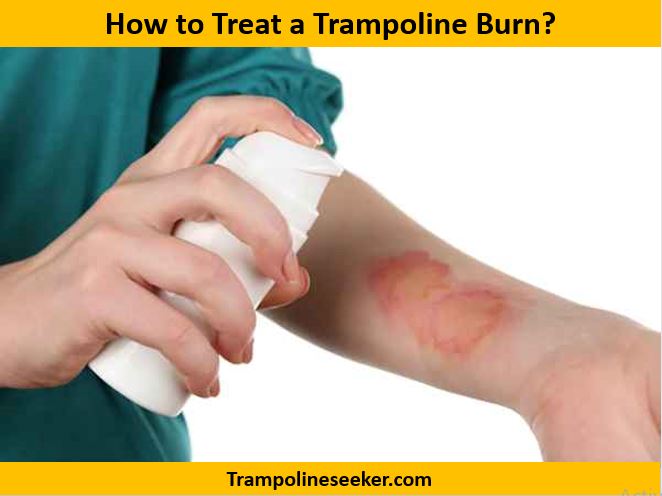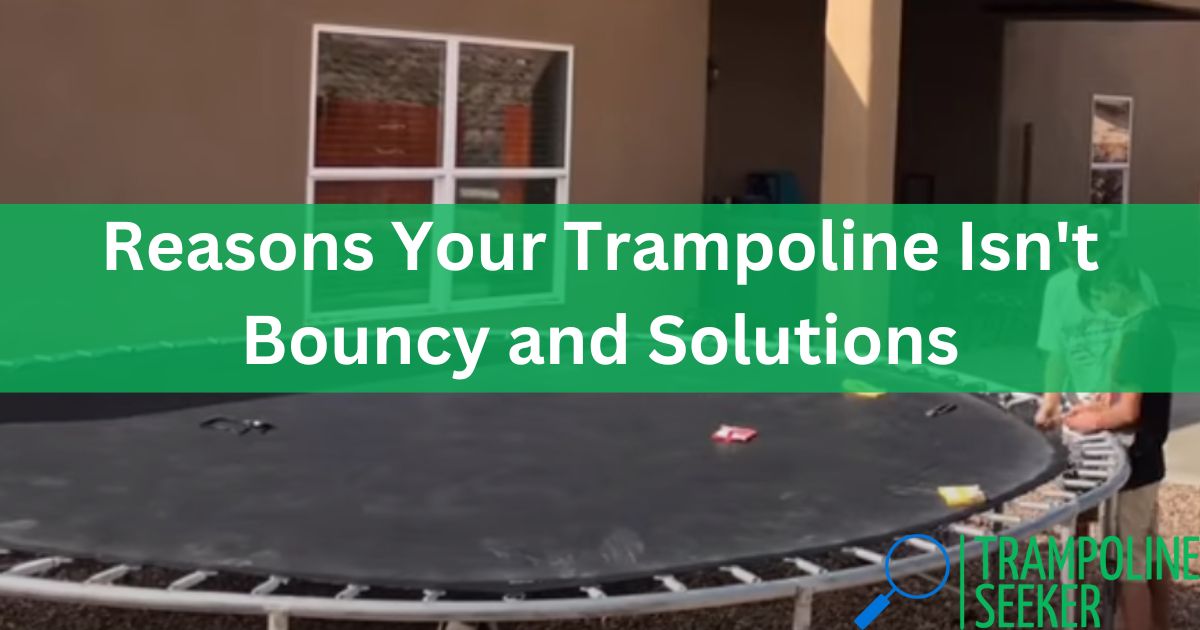A trampoline is a fantastic piece of exercise equipment that can add hours of excitement and health benefits to your life. Trampolines can be quite costly and fussy to maintain. Pay close attention to the trampoline’s springs if you want it to last as long as possible and perform at its best. Rust is a common problem for trampolines stored outside, as both dew and rain can corrode the metal. You can use a simple remedy from your kitchen to get rid of the rust on your trampoline’s springs.
So, How to Remove Rust from Trampoline Springs? To get rid of rust stains on trampoline springs, mix equal parts of white vinegar and water and spray it on the springs. Dish soap works as well.
Related Topics:
| Is Zupapa a Good Trampoline |
| What Size Trampoline for 2 Kids |
| How to Fix Trampoline Net |
| How to Prevent Trampoline from Rusting |
| How High Do Trampoline Gymnastics Jump |
Common Cause Why Trampoline Springs Rusting
Strong trampoline springs are designed to do more than just keep the trampoline from collapsing when you jump on it. As part of your trampoline’s routine upkeep, make sure to replace them as they serve an important safety function.
Inadequate lubrication increases the likelihood that springs will rust. However, rust will form on the springs if they are not lubricated. Rust will cause dirt to accumulate in your trampoline, making it heavier and more difficult for your children to use.
When the net is not regularly removed and cleaned, it cannot collect all of the leaves and rainwater, which causes the springs to rust.
Rust is forming on trampolines left outside in the rain. This happens when the netting has defects like holes or cracks. If you want to keep your trampoline in use and avoid injuries, you can ask your quality trampoline retailer how often you should replace them.
How to Remove Rust from Trampoline Springs?
If your springs have any rust on them, you should get rid of it completely before oiling them or else you risk making the rust worse. A wire brush may be necessary for severe rust removal and rust treatments.
Use a wire brush with a chemical rust removal solution
Start by applying a wire brush to the rust with trampoline rust remover. Soak the wire brush for 10 minutes in a chemical rust remover. After soaking for 10 minutes, use the wire brush to remove the rust, then wash the trampoline and dry it with a cotton rag.
Use a wire brush with a homemade rust removers of baking soda and vinegar
Use a wire brush or grit to get rid of rust while your trampoline is still on the ground. If your trampoline is already set up, however, this won’t help.
To remove rust from your trampoline springs, mix baking soda and white vinegar (or use regular vinegar) and scrub the springs with a wire brush. For optimal results, use a scrub brush when applying the solution. In order to remove rust, mix a cup of salt with a water-repellent solution and scrub the area with a wire brush.
Use a wire brush with DIY rust removers of cup of salt and water repellant solution
A bucket of fresh water and one cup of each should do the trick. Take a sponge and wash the trampoline with the bucket’s water. Rust can be eliminated with a solution of salt and water.
Spray the rust with WD-40
Rust can be eliminated with a WD-40 spray. Rust can be removed by spraying the area with WD-40. After allowing it to sit for a while, use a wire brush or steel wool to get rid of the stubborn rust, and then wipe the area down with a clean cloth.
Are Rusty Trampoline Springs Safe to Use?
The trampoline’s springs are crucial to the product’s features and functions. In good condition, they can enhance the trampoline’s ability to absorb the impact of your jumps. It would be dangerous and costly if the frame were to break due to age or rust.
Indeed, trampoline springs that have begun to rust are no longer usable. In wet environments, they risk rusting and becoming potentially hazardous. The fatigue life of rusty springs increases when subjected to stress. The springs could snap while in use, potentially killing the user.
The trampoline’s springs are the primary source of injury. A jumper can gain a lot of momentum from the springs, but if they snap, they could cause serious harm.
Tips for Trampoline Care
The trampoline’s springs are an essential part of the trampoline’s functionality and safety. Trampoline operation relies on these springs; how can you keep them from rusting?
- A galvanized coating, like zinc or chrome, is recommended for weather resistance.
- In the absence of a galvanized coating, a regular spray-on will do. A protective cover or anti-rust spray should be used to prolong the life of the springs.
- A Trampoline Cover will protect your trampoline’s springs from the elements and keep them from rusting.
- Use a rust-inhibiting oil to prevent springs from rusting.
- Be sure to regularly wipe down the metal surface of your trampoline to prevent the buildup of rust, which can weaken or even break the trampoline’s springs.
- Rust is inevitable on the frame and the springs. However, a protective coat of anti-rust paint, such as a zinc primer, will prevent them from rusting.
Applying the spray paint layer with a roller or sprayer ensures that the paint adheres to the springs and frame for the longest possible time.
How to Stop Trampoline from Squeaking?
I evaluate some tips for keeping your trampoline quiet. If you work with sharp pieces of metal, keep your hands safe first. If you are not familiar with trampoline springs, be careful if you are working with them. What do we need to do to stop our trampoline from bouncing?
In short, you can get rid of Trampoline Squeaking by following this checklist:
- Clean The Trampoline Mat
- Use Rust Remover
- Clean The Trampoline Frame
- Spray-On Springs with WD-40
- Grease The Joints
- Repair or Replace Any Damaged Springs
- Handle The Patch
- Use Bolts Instead of Screws
- Secure The Trampoline Properly
What Is the Fastest Way to Remove Rust from Metal?
A commercial rust remover is the quickest option. The metal underneath the rust can be safely and easily stripped away with the help of these products. On the downside, they aren’t cheap, so you might want to look into cheaper alternatives. No matter the metal or the severity of the rust, there is no universally effective method for removing it.
Can I Use Steel Wool to Remove Rust from Metal?
It is possible to use steel wool to remove light surface rust from metal, but this method is not recommended for heavily rusted surfaces. Scratches and abrasions from using steel wool can speed up the rusting process. therefore, think about how bad the rust is and if steel wool is the best option for it.
How Can I Prevent My Trampoline from Rusting?
Applying a protective layer of paint or sealant to your trampoline is one of the best ways to keep it from rusting. Use a rust inhibitor, such as an oil or wax, to prevent rust. Before applying a protective coating, you can try cleaning and restoring an item that has already rusted. In order to find the best coating to prevent rust, you may want to do some research.
What Dissolves Rust Fast?
Vinegar and salt mixture
This is a home remedy for getting rid of superficial rust. The rust is easier to scrub off after the vinegar has softened the surface.
Commercial rust remover
These products are made to safely and efficiently remove rust from metal surfaces.
Wire brush
To remove light rust, a wire brush can be used. If the metal is fragile, use a softer brush.
Steel wool
Steel wool can be used to clean metal surfaces of light surface rust, but it shouldn’t be used on heavily rusted surfaces. Scratches and abrasions from using steel wool can speed up the rusting process.
Paint or sealant
For rust prevention, coating metal with paint or sealant is a good idea.
Wax or oil-based rust inhibitor
Metals can be protected from rust by coating them in wax or oil-based rust inhibitors. To function, they create a barrier that keeps the metal safe from the atmosphere.
Cleaning and restoring
In some cases, rust can be removed and the item restored before a protective coating is applied. There will be less corrosion because of this.
Does Vinegar Damage Metal?
Vinegar will not destroy the metal in any way. The rust on metal objects can be removed with it. Vinegar can be a useful cleaning product, but it shouldn’t be used on fragile surfaces because it can easily scratch or abrade them. If the metal is particularly fragile, for instance, you might want to use a wire brush instead of a vinegar and salt mixture. Also, since vinegar can be corrosive, it’s important to give the item a thorough rinsing afterward.
Can I Use Coca-Cola to Remove Rust?
Coca-Cola will not work as a rust remover. The situation may even become direr. Coke is a fizzy drink that contains acids that can corrode metal. So, you shouldn’t use Coca-Cola to clean metal items that have rust on them. Countless sources have debunked this urban legend.
What Chemical Removes Rust?
Typically, hydrochloric acid is the chemical of choice when trying to get rid of rust. There is a risk of harm when using it, so exercise caution. Many different chemical-based rust removers are available for purchase. Before using a chemical to get rid of rust, make sure you read the instructions on the label.
For example, phosphoric acid can be used as an alternative chemical for rust removal. It can be found in many over-the-counter rust removers and poses less of a threat than hydrochloric acid. Phosphoric acid has many uses because it is safe to use, biodegradable, and does not corrode the metal underneath.
How Do You Remove Rust Without Scrubbing?
Rust can be scrub-free removed in a few different ways. A commercial rust remover is one option. To remove rust, these products employ various chemical processes. Phosphoric acid is another viable option. Typically found in commercial rust removers, this chemical is safer than hydrochloric acid but still effective. Wax or an oil-based rust inhibitor is another option.
The use of such products helps to create a barrier between the metal and the air, which inhibits the formation of rust. To finish up, you can try sealing or painting the metal object. This will prevent any rust from forming and keep it looking brand new for a long time.
Can You Use Vinegar to Remove Rust?
Yes, vinegar can be used to remove rust. It is one of the most typical approaches to dealing with this kind of corrosion. You can use a wire brush or a mixture of vinegar and salt to remove the rust. Due to its corrosive properties, vinegar must be rinsed off completely before being used on an object.
Furthermore, white vinegar, which contains 5% acetic acid, is an excellent choice for rust removal from metal. If the item is heavily rusted, apple cider vinegar, which contains 6-8% acetic acid, may be more effective. Before using vinegar on the entire metal object, test it on a small, hidden area. White vinegar is more common and cheaper than apple cider vinegar.
Can Baking Soda Remove Rust?
Rust cannot be removed with baking soda. The situation may even become direr. Given its basic nature, baking soda can combine with rust to produce sodium iron oxide. Unfortunately, doing so will only speed up the rusting process and make cleanup a bigger hassle down the road.
Does Bleach Remove Rust?
There are two schools of thought regarding bleach. People have mixed opinions on whether or not bleach can be used to remove rust without damaging the metal. For now, it’s best to avoid using bleach on a large metal object without first conducting a small test. Bleach can be used to clean metal, but it must be diluted with water and applied carefully to avoid damaging the surface.
Can I Use WD-40 To Remove Rust?
WD-40 is not a rust remover, but rather a lubricant. Rust will still form, but this method may help prevent further rusting in the future. Avoid using WD-40 and instead turn to a chemical or commercial rust remover if you need to clean rust from metal. It has been suggested that WD-40 can be used to clean rust from tools, but this should be done only if all other methods have failed.
How Long Does It Take Vinegar to Remove Rust?
If the corrosion is severe, it may take longer for the vinegar to dissolve the rust. Rust can usually be removed in a matter of minutes with the vinegar and salt solution. It could take more time and effort to completely remove heavier rust. Wire brushes can also be used to remove rust.
Does Toothpaste Remove Rust?
Toothpaste may cause damage to the metal due to its abrasive ingredients. If you want to try removing rust with toothpaste, do a test spot first to make sure it doesn’t eat away at the metal. Additionally, since toothpaste can be corrosive, it is important to thoroughly rinse the object after use.
Does Alcohol Remove Rust?
Attempts to remove rust from metal with alcohol were generally unsuccessful. Instead of using alcohol, which could potentially corrode the metal, you should use water. Avoid using alcohol and give one of the other methods a try if you need rust removed in a safe and effective manner.













